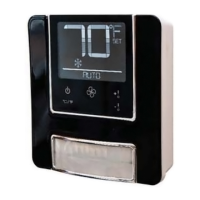53
ASSA ABLOY Hospitality
66 8003 015-3
Appendix B: Troubleshooting
A/C unit cooling when calling for heat (and vice versa)
1. If the unit is a heat pump, make sure that the thermostat is properly configured to
control the heat pump. See Daily use manual Orion High Voltage Thermostat for
proper configuration of a heat pump.
2. If the unit is not a heat pump, or if the thermostat is correctly configured, check the
outputs of the thermostat to ensure that it is calling for heat or cool properly.
a. First check the outputs at the thermostat.
i. If OK, check the outputs of the thermostat at the connection to the HVAC
unit. It is possible that the wiring is crossed or somehow incorrect.
ii. If all is OK, the property needs to have their HVAC technician check the unit.
b. If the thermostat outputs are incorrect:
i. First check the configuration of the thermostat by using Orion Service to read
out the parameters of the thermostat; do not just rely on looking at the
parameters in the Visionline or Orion EMS software. If the parameters are
incorrect, make the necessary changes.
ii. Connect a new thermostat to see if the problem disappears. If it does, replace
the thermostat. If the problem stays, there is a problem with the wiring or
parameters that must be fixed.
Fan continues to run even when the thermostat is turned off
1. First, wait a couple of minutes to see if the fan does eventually turn off. Some air
handlers have a built-in function that keeps the fan running for a time after the
heating or cooling function is turned off.
2. Secondly, use Orion Service to check the parameters of the thermostat – ensure
that the ‘Fan on when satisfied’ function is set to ‘no’.
3. Finally, test the outputs of the thermostat to see which ones that are on. If a fan
output is active and the thermostat is not calling for fan (use the Diagnostics
feature of Orion Service to confirm that the thermostat is not calling for fan),
change the thermostat as it has a stuck relay. If no fan output is active, check all
other outputs to find out if any are active. It is possibly a crossed or shorted wire.

